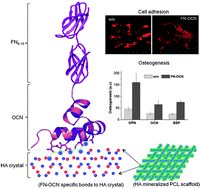Modifying three-dimensional scaffolds with bioactive extracellular matrix (ECM) molecules enhances their potential use in tissue engineering, by providing natural biochemical/physical cues for cell recognition. Here, we engineered the surface of poly(caprolactone) (PCL) scaffolds, first with bone mineral hydroxyapatite (HA), and then with fibronectin–osteocalcin (FN–OCN) bi-functional protein by means of affinity binding between OCN and HA. While FN is expected to enhance initial adhesion of immature precursor cells, OCN is considered to regulate osteogenic differentiation. Quartz crystal microbalance dissipation analysis revealed FN–OCN protein had a more stable and stronger adherence to the HA-mineralized surface than to the native PCL-surface. Initial adhesion and the spreading of rat mesenchymal stem cells were significantly enhanced on the FN–OCN tethered scaffold. Expression of bone-associated genes (osteopontin, bone sialoprotein II and OCN) was significantly higher on the FN–OCN tethered scaffold. Moreover, those proteins were more abundantly found when cultured on the scaffolds with FN–OCN than those without, as confirmed by immunofluorescence cell labeling and fluorescence activated cell sorting analysis. All taken, the tethering of FN–OCN to a HA-mineralized surface is an effective strategy to provide biopolymer scaffolds improved bi-functional capacity for bone tissue engineering, in terms of initial cell adhesion and osteogenic differentiation.

